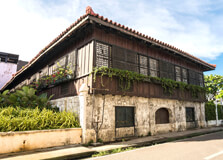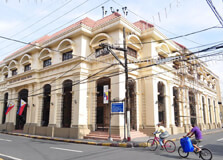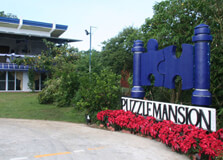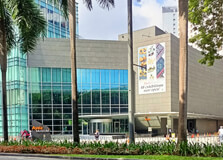
- Home
- Travel Packages
- Top Destination
-
Travel Attraction
By Category
Top Attraction

- Travel Agents
- Car Rentals
- Hotels

Originally a private home, Casa Gorordo Museum is considered among one of the best preserved wood-and-stone house built in the 1850s. The museum showcases, paintings, religious relics, ceramics and antique furniture. It also displays traditional Filipino home and modern art exhibits. Life-size statues of saints are an added attraction in the museum. The museum is maintained by Ramon Aboitiz Foundation, Inc and the landmark provides an insight into the Cebuano lifestyle. HistoryAlejandro Reynes y Rosales built the house in the 1850s. It was later bought by a Spanish merchant in 1863. Ramon Aboitiz Foundation Inc. (RAFI) bought the house in 1980 under their Cultural Heritage Program. In 1983, it was opened as a museum. The house was declared as a National Historical Landmark in 1991. ConstructionThe museum is a two- story house with the lower part built with coral stone blocks and terra-cotta roof tiles. The upper-storey is made with pure Philippine hardwood, held with wooden pegs. Location · Cebu City, No. 35 Lopez Jaena Street, Barangay Parian. Opening hours · The Museum is open to the public from 10:00 am to 6:00 pm, from Tuesday to Sunday. It is closed on Mondays and national holidays. ActivitiesThe Casa Gorordo Museum offers educational tours and activities like history lectures and art exhibitions. PricesFor foreign tourists the entrance admission is PhP70 for adults and PhP50 for students. The rates for local tourists are PhP40 for adults, PhP15 for college and school students and PhP10 for elementary school students.
Explore More
Bahay Tsinoy is a famous museum situated in Intramuros (Old Walled City) section of Manila. The museum exhibits the history and lives of Chinese overwhelmingly. In the museum, the visitors can explore the Philippine life and history, especially the significant contribution of Chinese in it. Establishing Year & Inauguration Late architect Honrado Fernandez collaborated with Eva Penamora and the beautiful museum was designed. The designing work of the museum was completed in the year 1996. The museum was inaugurated in the year 1999. Funding & Support It was Angelo King Foundation that funded the land and building. The contributions from varied Filipino-Chinese community segments such as from taipans to average wage-earners also aided in erecting the museum. Different Sections of Museum Colonial culture Gallery of rare prints and photographs Rare Philippine shell collection Early contacts Ceramics collection Life in the 1800s Tsinoys in nation-building (inaugurated in 2004) The Parian National leaders of Chinese descent Martyr's hall Emergence of the Chinese community In defense of freedom Various Offices & Halls in Museum Office of Kaisa Para sa Kaunlaran, Inc. Chinbin See Memorial Library Await Keng Theater Auditorium Benito Cu Uy Gam Hall Pao Shi Tien and Madame Limpe seminar rooms
Explore More
Puzzle Mansion in Tagaytay, Philippines, is a unique and intriguing attraction that draws visitors from all walks of life. As the largest collection of jigsaw puzzles in the world, Puzzle Mansion is not only a museum but a testament to the beauty of patience, creativity, and dedication. Nestled in the cool, serene hills of Tagaytay, the mansion is a haven for puzzle lovers and curious tourists looking for a distinctive experience in the area. Whether you're an enthusiast of puzzles or simply someone who enjoys art, history, and scenic views, Puzzle Mansion offers an unforgettable visit. How to Reach Puzzle Mansion, Tagaytay, Philippines Puzzle Mansion is located along the scenic Tagaytay-Nasugbu Highway, about 4-5 kilometers from the center of Tagaytay. The easiest way to get to Puzzle Mansion from Metro Manila is by taking the South Luzon Expressway (SLEX) and exiting at Sta. Rosa. From there, continue on the Tagaytay-Nasugbu Highway, following the signs to Tagaytay, and look for signs pointing to Puzzle Mansion. The entire journey takes about 1.5 to 2 hours, depending on traffic conditions. If you're relying on public transportation, you can take a bus from the Pasay or Buendia terminals in Manila heading to Tagaytay. Once in Tagaytay, you can take a tricycle or jeepney to Puzzle Mansion. The tricycle ride is a short, convenient option from the town center. Weather at Puzzle Mansion, Tagaytay, Philippines Tagaytay enjoys a relatively cool and refreshing climate, thanks to its high elevation at about 2,000 feet above sea level. This makes it a popular destination for locals seeking relief from the heat of Metro Manila. The average temperature in Tagaytay ranges from 22°C to 30°C year-round, with cooler temperatures in the evenings and early mornings. Tagaytay has a tropical climate with two distinct seasons: the dry season from December to May and the rainy season from June to November. The best time to visit Puzzle Mansion is during the dry season, especially from December to April, when the weather is more favorable for outdoor activities and sightseeing. However, even during the rainy season, Tagaytay remains cooler and enjoyable, albeit with occasional rain showers. Why Puzzle Mansion, Tagaytay, Philippines is Famous Puzzle Mansion is famous for housing the largest collection of jigsaw puzzles in the world, a title recognized by the Guinness World Records. The collection, which consists of thousands of puzzles from different parts of the globe, is a major attraction for puzzle enthusiasts, tourists, and families alike. The mansion was established as a passion project by Mrs. Virginia “Gina” Garcia, a former school teacher and puzzle enthusiast who dedicated her life to collecting and preserving these fascinating works of art. In addition to its impressive collection of puzzles, Puzzle Mansion is also well-known for its tranquil ambiance and beautiful surroundings. Visitors can enjoy the scenic views of Taal Volcano and Taal Lake from the mansion, adding an extra layer of charm to the overall experience. The mansion itself is also a unique architectural structure that blends modern design with traditional Filipino aesthetics, providing a pleasant setting for its world-class collection of puzzles. Entry and Visit Details About Puzzle Mansion, Tagaytay, Philippines Puzzle Mansion is open to the public daily, and it offers an enriching and engaging experience for people of all ages. The entrance fee is affordable, typically around PHP 100 to PHP 150 per person, though the price may vary depending on the season and any special promotions. This entry fee gives visitors access to the various exhibits and rooms filled with puzzles, allowing them to explore the extensive collection at their own pace. The museum is open from 9:00 AM to 6:00 PM, providing ample time for visitors to enjoy the exhibits. It’s best to arrive early to avoid the crowds, especially on weekends or during holidays, as the attraction can get busy with families and tourists. Guided tours are also available for those who want more insight into the history of the puzzles and the collection. History and Architecture of Puzzle Mansion Puzzle Mansion was founded in 2008 by Gina Garcia, who was inspired by her love for puzzles and her desire to share this passion with others. What started as a personal collection of jigsaw puzzles grew into a world-renowned museum, eventually earning the distinction of having the largest collection in the world. The mansion's walls are adorned with puzzles from around the globe, many of which have intricate designs, vivid colors, and cultural significance. The architecture of Puzzle Mansion is as intriguing as its collection. The building is a blend of contemporary and traditional Filipino design, with a spacious, open layout that allows for easy navigation of the exhibits. Visitors can explore several rooms filled with puzzles of all sizes, from large 3D puzzles to hundreds of smaller, intricately detailed pieces. The design of the mansion reflects the calm, creative energy of the place, allowing visitors to feel immersed in the world of puzzles. Things to Do at Puzzle Mansion, Tagaytay, Philippines There’s more to do at Puzzle Mansion than just viewing puzzles. Here are some of the top activities and experiences you can enjoy during your visit: Explore the Puzzle Collection: Puzzle Mansion houses thousands of puzzles, many of which are framed and displayed throughout the mansion. Each puzzle tells a unique story, with designs ranging from simple patterns to intricate masterpieces. The collection includes puzzles from various countries and artists, giving visitors an opportunity to appreciate the global appeal of jigsaw puzzles. Enjoy the Scenic Views: The mansion offers panoramic views of Taal Volcano and Taal Lake, which are perfect for photo opportunities. The lush greenery surrounding the mansion also adds to the peaceful atmosphere, making it a great place to unwind and relax. Try Your Own Puzzle: The museum offers visitors the opportunity to try their hand at puzzle-solving. There are areas with puzzles for all skill levels, from beginners to experts, so you can test your patience and skills while enjoying the process of putting the pieces together. Attend a Puzzle Workshop: Puzzle Mansion also offers workshops where visitors can learn more about the art of puzzle-making and jigsaw puzzle history. These workshops are a fun way to engage with the craft and learn new puzzle-solving techniques. Interesting Facts About Puzzle Mansion, Tagaytay Puzzle Mansion holds the Guinness World Record for having the largest collection of jigsaw puzzles, with over 1,000 puzzles in its collection. Many of the puzzles on display are donated by puzzle enthusiasts from around the world, making the collection truly international. Aside from jigsaw puzzles, the museum also showcases other types of puzzles, including 3D puzzles and wooden puzzles, adding diversity to the collection. The museum is one of the most unique attractions in Tagaytay, making it a must-visit for puzzle lovers and those looking for a one-of-a-kind experience. Tips for Visiting Puzzle Mansion, Tagaytay Visit Early or Late: To avoid the crowds, it’s best to visit early in the morning or later in the afternoon. This will allow you to enjoy the exhibits at a leisurely pace without feeling rushed. Wear Comfortable Shoes: As you’ll be walking around the mansion to explore the puzzles, comfortable footwear is a must. Bring a Camera: The scenic views and unique puzzles make for great photo opportunities, so don’t forget to bring a camera or smartphone. Plan for a Relaxed Visit: Puzzle Mansion is meant to be a relaxing place, so take your time and enjoy the calming atmosphere of the mansion. Check the Weather: Tagaytay has a cooler climate, but it’s still good to check the weather before heading out. Bring a jacket or sweater if you’re sensitive to cooler temperatures.
Explore More
Cordillera Sculpture Museum, Banaue
Though Banaue is mainly popular for its rice terraces, many who visit the region do not miss making visit to Cordillera Sculpture Museum too. There is a small fee that one has to pay before entering in the museum. The museum preserves the remnants of the dying Ifugao culture. In the museum, one can see the artifacts, and replicas of wood-carved memoirs. Every piece in the museum is placed well and a label is also provided. Each item carries with it a small paper beneath, providing information about the item. What to See in Museum? · The museum displays Cordilleran Tribal Sculptures.· It also exhibits the past structures of Northern Luzon’s farmers and carvers.· The second floor exhibits the carved sculptures.· Stairs also have Bululs. It is the necklaces and shafts that depict Bululs on them.· In the museum, the visitors can also see the utensils and armors of the natives. How to Reach Museum?· One can take ride of a tricycle from the terminal or market of Banaue. It only takes some five minutes or less by drive to reach to the museum. · One can also walk all the way uphill on road from the market to the museum. It only takes some fifteen minutes.
Explore More
Located in the heart of Makati, the Ayala Museum stands as one of the Philippines’ most distinguished cultural institutions. This museum is dedicated to showcasing the country’s rich history, culture, and art. With its extensive collection of Filipino heritage, from ancient artifacts to contemporary art, the Ayala Museum offers a deep dive into the diverse and fascinating culture of the Philippines. Whether you're an art enthusiast, history buff, or curious traveler, a visit to the Ayala Museum is an essential experience in Makati. How to Reach Ayala Museum, Makati The Ayala Museum is centrally located in the bustling Ayala Center, making it easy to access from various points in Metro Manila. Here’s how you can get there: By Taxi or Ride-Hailing Apps: Taking a taxi or ride-hailing service like Grab is the most convenient way to reach the museum. Simply input "Ayala Museum" as your destination, and you’ll be dropped off directly at the museum's entrance. By MRT: The nearest MRT station is Ayala Station. From there, you can take a short walk through the Ayala Center's pedestrian walkways to the museum, which is just a few minutes away. By Bus: Several buses traveling along Ayala Avenue pass close to the museum. You can alight at the Greenbelt or Ayala Center stops, both of which are near the museum. Walking: If you're staying at nearby hotels or are already in the Ayala Center, walking to the museum is a great option. The museum is centrally located, and the pedestrian-friendly walkways in the area make it easy to navigate. Weather and Best Time to Visit The weather in Makati is generally warm and humid, especially during the dry season from March to May. The rainy season lasts from June to September, with more frequent downpours. The best time to visit Ayala Museum is during the cooler months from November to February, when the weather is more comfortable. It is also important to note that the museum’s air-conditioned interiors provide a comfortable escape from the heat, so it’s a great place to explore during the day, regardless of the weather. Why Ayala Museum is Famous Ayala Museum is famous for its wide range of exhibits that reflect the rich cultural and historical heritage of the Philippines. Here are some reasons why it attracts visitors: Art and History: The museum houses a vast collection of Filipino art, including works from National Artists, as well as exhibits on the Philippines' historical and cultural heritage. Gold and Pre-Hispanic Artifacts: One of the most renowned features of the museum is its collection of pre-Hispanic gold artifacts, which offers insight into the sophisticated ancient cultures of the Philippines. Interactive and Immersive Exhibits: The museum features modern and interactive exhibits that make learning about Filipino culture both fun and engaging. The gallery of Filipino costumes, along with the contemporary art exhibits, provides an immersive experience. Cultural Events: The museum hosts regular cultural events, exhibitions, and programs that celebrate Filipino traditions, music, dance, and crafts. These events make the museum a living testament to Filipino culture. Entry and Visit Details Ayala Museum is open to visitors every day except Mondays, with regular hours from 9:00 AM to 6:00 PM. The museum offers a variety of ticketing options, including single-entry passes and special discounts for students, senior citizens, and groups. Visitors can also purchase tickets for special exhibitions or events. It is advisable to check the museum’s website or social media pages for updates on current exhibitions and any special events during your visit. The museum has a café and gift shop where visitors can enjoy refreshments and purchase unique Filipino-inspired products. It is recommended to allocate at least 1 to 2 hours to explore the museum, although art enthusiasts may want to spend more time appreciating the exhibits in detail. History and Architecture The Ayala Museum was established in 1967 and is part of the Ayala Foundation’s commitment to promoting Filipino culture and arts. Over the years, the museum has expanded its collection and transformed into a world-class institution for both art and historical exhibits. The museum’s architecture is a perfect blend of modernity and tradition. Designed by renowned Filipino architect Francisco Mañosa, the building showcases a minimalist style with clean lines and a spacious, open-plan interior. The museum’s design reflects a sense of balance between the modern city and the country’s traditional roots, which is especially evident in the central atrium, the heart of the museum. The structure also incorporates natural light through large glass panels, creating a welcoming atmosphere. Things to Do at Ayala Museum Explore the Exhibits: The Ayala Museum is home to a variety of permanent and rotating exhibits. Don’t miss the Gold of Ancestors collection, featuring intricate gold artifacts from pre-colonial Philippine civilizations. Also, check out the Bangsamoro Gallery, showcasing the art, culture, and history of the Moro people in the Philippines. Engage in Workshops: The museum often organizes workshops that allow visitors to learn about Filipino traditions, crafts, and arts. These activities are perfect for families or school groups looking to deepen their knowledge of Filipino culture. Attend Cultural Events: The museum frequently hosts cultural performances, from traditional Filipino dance to contemporary music performances. Keep an eye on the museum’s event calendar to catch one during your visit. Visit the Museum Shop: The museum shop offers a curated selection of Filipino handmade crafts, books, and artworks. It’s a great place to pick up a unique souvenir that reflects the country’s rich cultural heritage. Facts and Tips about Ayala Museum Tip: If you plan on visiting the museum during weekends, it’s a good idea to arrive early to avoid the crowds, especially during popular events or special exhibitions. Fact: The museum’s collection includes over 1,000 pieces of pre-Hispanic Filipino gold artifacts, making it one of the largest collections of its kind in the world. Tip: If you’re an art lover, make sure to check the museum’s schedule for temporary exhibitions, which often feature prominent contemporary Filipino artists. Fact: The Ayala Museum is not just a place for art and history; it also serves as a hub for educational programs, offering various workshops, seminars, and collaborations with local artists and historians.
Explore More
Museo ng Makati, also known as the Makati Museum, is a cultural landmark located in the heart of Makati, Metro Manila. Established to preserve the history, art, and culture of the city, the museum provides visitors with a fascinating glimpse into Makati’s past—from its humble beginnings as a small agricultural town to its current status as the country’s premier financial district. The museum showcases a wide range of exhibits, including historical artifacts, artworks, and a collection dedicated to the heritage of the Makati people. How to Reach Museo ng Makati, Makati Museo ng Makati is centrally located within the city, making it easily accessible via various forms of public and private transportation. Here are a few ways to get there: By Taxi or Ride-Hailing Apps: The easiest way to reach the museum is by taking a taxi or using ride-hailing services like Grab. Simply input "Museo ng Makati" in the app, and the driver will take you directly to the museum. By MRT: The closest MRT station is Ayala Station, located about a 15-minute walk from the museum. From the station, you can take a short walk or a jeepney to the museum. By Bus: Several buses travel along Ayala Avenue and other major roads in Makati. You can alight at the nearby Ayala Center or Greenbelt stops and walk to the museum from there. By Jeepney: Jeepneys that pass through Makati Avenue or Ayala Avenue can also take you near the museum. Alight at any stop that is closest to the Ayala Museum area, and walk to the museum. Weather and Best Time to Visit The weather in Makati is generally warm and humid, with two distinct seasons: the dry season (from November to April) and the rainy season (from May to October). The best time to visit Museo ng Makati is during the dry season, when the weather is more pleasant and conducive to walking around the area. Though the museum is air-conditioned and provides a cool environment indoors, it’s still advisable to visit during the cooler months to avoid the intense humidity and rain, which may hinder your exploration of the city and its surroundings. Why Museo ng Makati is Famous Museo ng Makati is famous for its diverse collection of artifacts, artworks, and exhibits that highlight the city’s rich cultural and historical heritage. The museum’s importance lies in its role as a repository of Makati’s history and as a venue that preserves the Filipino culture. Here’s why it’s so well-loved: Historical Significance: The museum is dedicated to preserving Makati’s transformation from a rural town to a bustling metropolis, offering insight into the city’s development over the centuries. Extensive Collection of Artworks: The museum features a wide array of Filipino art, particularly from local Makati artists, showcasing the talent and creativity of the city’s residents. Educational Programs: Museo ng Makati is also known for its educational programs and workshops, which are designed to engage students and visitors in learning about the city’s history and culture. Unique Cultural Displays: The museum’s exhibits include a rich collection of traditional Filipino artifacts, including indigenous crafts, textiles, and historical tools. Entry and Visit Details The Museo ng Makati is open to the public with affordable entry fees. The museum’s regular hours of operation are from Tuesday to Saturday, 9:00 AM to 5:00 PM, and it remains closed on Sundays and Mondays. It is best to check the official website or social media pages of the museum for any updates, special events, or holiday schedules. Admission to the museum is free for children, senior citizens, and students, while regular adult visitors will need to pay a small fee. Special discounts may be offered for groups, school tours, and special programs. The museum also provides guided tours for visitors who want an in-depth explanation of the exhibits. These tours are available upon request, and it’s a good idea to book in advance if you have a large group or are visiting during peak tourist seasons. History and Architecture Museo ng Makati was established to provide a platform for preserving the history and culture of Makati. The museum occupies a heritage building that was originally constructed as a school in the 1960s. Over the years, the structure was renovated and repurposed to house the growing collection of historical artifacts and artwork. The architecture of the museum reflects a mix of contemporary design with traditional Filipino elements. The building’s design is simple yet elegant, with wide, open spaces for displaying exhibits. Inside, the museum is designed to provide visitors with a comfortable, well-lit environment in which to appreciate the art and artifacts on display. Its modern aesthetic blends seamlessly with the cultural significance of the artifacts and collections housed within. Things to Do at Museo ng Makati Explore the Exhibits: Museo ng Makati showcases a variety of exhibits focusing on the city’s history, art, and culture. Highlights include photographs, historical documents, and antique Filipino artifacts. There are also rotating exhibits that showcase contemporary art from local artists. Participate in Workshops: The museum offers workshops and educational programs aimed at deepening visitors’ understanding of Filipino culture, such as weaving, traditional crafts, and painting. Attend Special Events: The museum hosts a variety of cultural events throughout the year, including art exhibits, musical performances, and lectures on Filipino history. These events are often free or available at a discounted rate. Learn from the Museum’s Collection: If you are a history enthusiast or an art lover, the museum is a great place to learn about the evolution of Filipino culture and how it has shaped the development of modern-day Makati. Facts and Tips about Museo ng Makati Tip: If you're visiting with children or a school group, be sure to arrange for a guided tour to make the most of your visit. The museum offers educational materials that are engaging and informative. Fact: Museo ng Makati is one of the best places to experience the rich cultural history of Makati, with a focus on the local heritage and the city’s transformation over the years. Tip: The museum can get busy during school holidays or special events, so plan your visit on a weekday for a more relaxed experience. Fact: The museum is part of a network of cultural institutions in Makati, making it an ideal starting point for a cultural tour of the city. Tip: When visiting the museum, take time to explore the surrounding area. The museum is located near other attractions such as Ayala Triangle Gardens and Ayala Museum, which are great spots to visit before or after your trip to Museo ng Makati.
Explore More